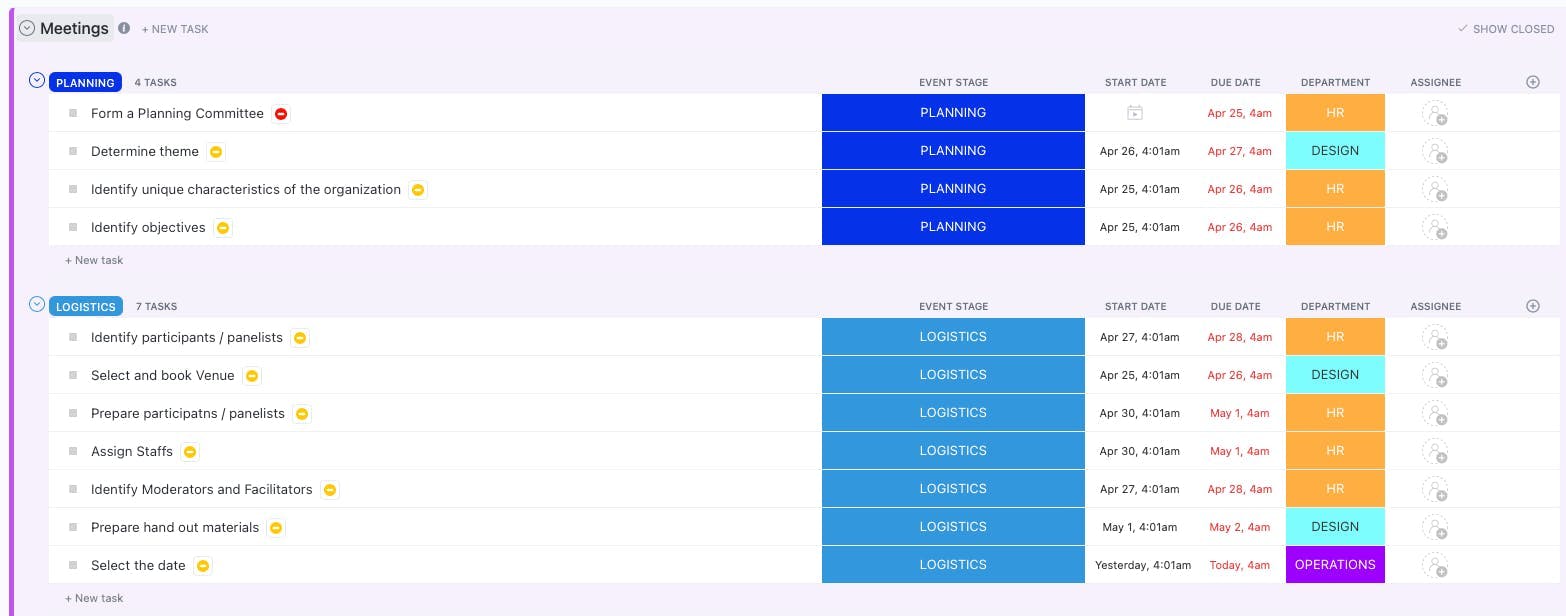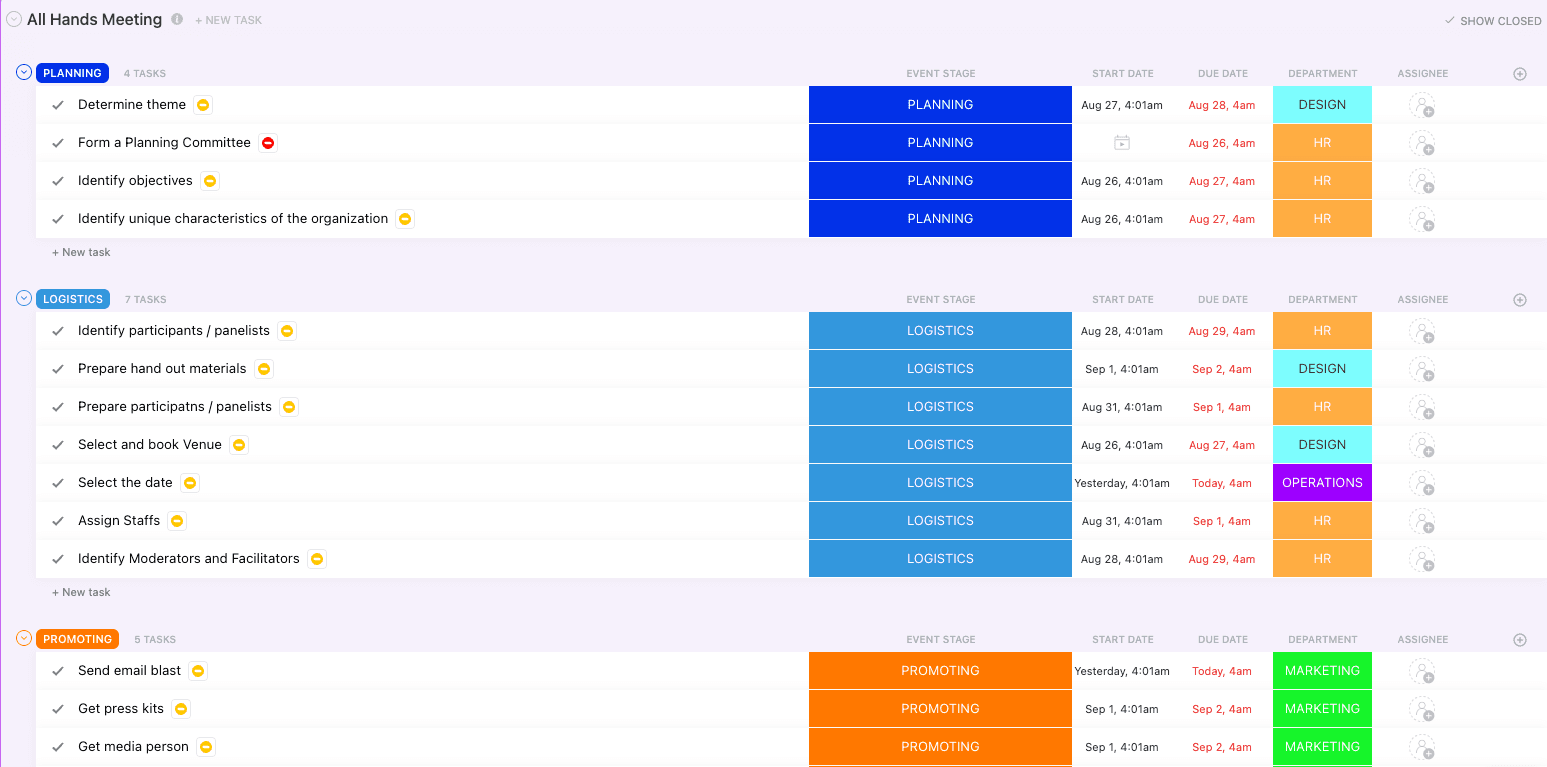11 Types of Meetings Project Managers Need to Master

Almost every industry has project managers or people with similar responsibilities. Project managers work in all kinds of industries, including construction, event coordinating, health care, and tech. Their role is universal which makes their job challenging and complex.
With organization being at the forefront of a good project manager's skillset, mastering the art of successful meetings comes hand-in-hand with that skill.
Project meetings are used to communicate with participants and stakeholders to discuss issues, develop proposals and approve or decline an offer. A project manager is responsible for the development of group decisions which aid in the faster delivery of the work plan as well as for determining the desired outcomes.
Along with skills, there are also a couple of tools and solutions that can help handling multiple meetings more manageable for project managers.

ClickUp is one of the best tools that we've come across. It is an all-in-one productivity tool that teams of any size and across different industries turn to for a powerful work management solution. It's completely customizable and offers a feature-rich experience to manage your workload, monitor project updates, create beautiful Docs to house your meeting notes, and communicate with the team.
You'll also use existing meeting templates to guide your meeting. For project management meetings, especially with remote collaboration, this means using a project-specific meeting template.
Get started with a meeting template and follow along with us.

You may be wondering, how do I know which type of meeting template to use? 🤔
There is a unique project management meeting for each type of project a team can undertake.
To successfully conduct project meetings, the meeting host should always document the conversion by saving the meeting minutes.
Understanding the different project meetings and how to run them effectively will help you save time and achieve your goal and meeting agenda.
Different Types of Project Management Meetings
There are two main types of project management meetings: reoccurring and standard project management meetings. Reoccurring project management meetings are held regularly throughout a period of time, whereas standard meetings are specific to the team’s context.
Let's get started:
Reoccurring project management meetings

Reoccurring project management meetings repeatedly happen throughout a project. For example, while developing a new feature, the engineering team will generally meet regularly to check in. In these meeting threads, one of the best practices is to use a template for recurring meeting notes.
Weekly project check-in meeting
Weekly project check-in meetings are regular team meetings where the project manager can sync with their project team to get a project status report. These check-in meetings are essential to ensure the project schedule is on track and team members are aligned with the project goals.
This type of project meeting is typically a recurring project status meeting that are held in all departments, as all teams involved must discuss project status and ensure each project team is on the same page. The attendees should include key stakeholders and every team member working on the project.
For example, a project check-in meeting with the engineering team, who’s developing a new feature, must gather and involve all key project team members including the engineers, engineering project manager, product managers, and designers should be included in the meeting.
Weekly project check-in or status review meetings should include a discussion on the updates from each project team member or team lead and a summary of the action items and the next steps leaving the meeting. During the updates, questions like the following should be answered:
- What did each team and team member do last week?
- What are they doing this week?
- What questions need to be answered?
Tip: review this list of check-in meeting questions to guide your check-in meeting.
Project Kick-Off Meeting
A project kick-off meeting is the first meeting to officially kick off the start of the project. It occurs during the initiation stage of the project phase and is usually led by the project manager. Since these meetings are held at the start of a new project, they generally signal that the execution phase is beginning.
Project kick-off meetings can be held within many different departments. For example, a marketing team can have a kickoff meeting when launching a new project, such as a new blog series or a newsletter, just like the product team can start developing a new product line by scheduling a new meeting.

Try this project kickoff meeting template.
Most importantly, project managers must ensure that they hold a well organized meeting to ensure everyone is on the same page and is aligned on all key factors to project success—they should be informed about the project plan, goals, timeline, major milestones, deliverables, budget, and reserved resources.
As for the scope of the meeting, it depends on the size of the project. Larger projects with multiple phases can have a new kick-off meeting at every stage, while smaller projects generally only have one kick-off meeting, but it can vary depending on your project goals and key milestones.
When scheduling your project kickoff meeting, invite the following relevant guests: project manager, team leads and managers, project contributors, clients, and other influential stakeholders. This is important as it establishes the baseline of communication, but it is also an opportunity to engage the project management team.
Want a top-level overview of the different project management stages? Read ClickUp’s guide on project management stages.
Post-Mortem Meeting
A post-mortem meeting is held at the end of a project to reflect on the completion of the project. During these project review meetings, the people who worked on the project gathered to provide feedback and reflections on what was successful and where it could have been improved.
Investing 30 minutes to one hour at the end of a project in documenting the key learnings, best practices, and mistakes made during the project is an essential long-term investment in your team’s productivity. By documenting in a meeting minutes app which decisions made during the course of the project were beneficial and which weren’t, the team eliminates the risk of repeating the same mistakes over time.

Collect your post-mortem ideas in this template.
Before coordinating this meeting, it can be useful to send a feedback poll to gather everyone’s thoughts. Within this poll, questions can include:
- Were the goals of the project clear?
- Were communications handled efficiently and effectively?
- Were updates/changes transparent to all stakeholders?
- What unexpected obstacles arose that affected the ability to meet milestones?
- What additional information would have facilitated the project workflow?
Try this post-mortem meeting template by Simon Heaton, Director of Growth at Buffer and previous Growth Lead at Shopify.
Project coordinator daily check-in
Certain projects require daily check-ins to align the team on the direction, therefore this type of status meeting typically includes all the project coordinators, managers, and team members.
These project status meetings are generally required for projects where significant progress is made every day or toward the project due date. For example, in event planning, the week before the event, it could be beneficial to check in on the final details of the event coordination the days before the event.
One of the best practices for your check-in meetings is to do a temperature check with your team members before starting the meeting. This involves asking how everyone is feeling before starting the meeting. Afterward, there should be a brief update on the project scope status, everyone’s priorities, performance reports, potential blockers and bottlenecks, and a summary of the action items.
Tip: track your action items from the meeting in your project management tool to build accountability across the team.
All Hands Meeting
An all-hands meeting, or town hall, is an opportunity for the entire organization to gather, align and drive transparency to keep your team engaged. In these meetings, all employees, leaders, and appropriate stakeholders will discuss company-wide matters.
A successful all-hands meeting will seek to accomplish the following four goals:
- Share business updates
- Align the team around the company mission and strategy
- Celebrate the team and milestones
- Answer questions publicly
In episode 110 of the Supermanagers podcast, Matt Martin, the CEO of Clockwise, explained that their weekly 1 hour long all-hands meeting includes a discussion on company updates, department presentations, and an opportunity to leave the meeting on a positive note by sharing funny moments from the week.
It is important to note that the size of your company can inform if the meeting is at a departmental or regional level. Some topics can be too granular for an entire company, so creating a space to go deeper into specific topics can be beneficial.

Try ClickUp’s all hands meeting for an engaging weekly meeting.
Board of directors meeting
A board of directors is a group of people that meet regularly to supervise the activities of an organization. These groups exist in non-profit organizations, as well as in private and public business organizations or government agencies.
The group formally meets to discuss reoccurring and significant issues, such as policy issues, legal business or KPI reporting, or miscellaneous issues.
These regularly scheduled meetings can be held at various intervals, whether they are quarterly or yearly. The chair will preside over the meeting, and the meeting notes are recorded as meeting minutes. These serve as legal documents to communicate between the organization, the board, and various external stakeholders.

Try ClickUp’s board of directors meeting template
Standard Project Management Meeting
Standard project management meetings are the classic set of meetings that most project managers are aware of or have used. These types of meetings use frameworks and methodologies that are fundamental to project management.
Agile project kick-off meeting
Agile project management or agile meetings is a methodology characterized by building products using short cycles of work that allow for rapid production and constant revision. An agile project kick-off meeting is, therefore, the first meeting to launch a project using an agile framework.
The agenda should convey the high-level project overview and overarching strategy, project schedule, vision and scope, and team roles and responsibilities. It should also include an explanation of the agile framework and what supporting ceremonies and meetings will be held. To close the meeting, there should be a list of action items.

Try ClickUp’s agile project management meeting template
Daily scrum meeting
Scrum is a framework to help teams work together; it encourages teams to learn through experiences, self-organize while working on a problem, and reflect on their wins and losses to improve continuously. It emphasizes teamwork, accountability, and iterative progress toward a well-defined goal.
In a daily scrum meeting, the team members working on a project should meet to discuss:
- What they worked on yesterday
- What they are working on today
- if they have any blockers
To wrap up the meeting, a best practice is to list all the action items and assign them to different team members. This fosters accountability across the team.

Try ClickUp’s agile meeting scrum management template for an organized and effective daily meeting.
Quality analyst project kick off
When a team of developers starts a new project, cross-functional collaboration is often required across different teams. For example, developing a new product feature also requires the design team and the product team to share input and complete tasks. Quality analyst project kick-off launches the quality analyst portion of a new project.
A quality assurance specialist, or quality analyst, monitors an organization's quality standard. This will be done by inspecting and proposing measures to correct or improve the product.
Specific teams have multiple QA specialists, others only have one that reports to the product leaders. Consequently, a quality analyst project kick-off should include all the QA specialists on the team or the QA and their manager.
During the kick-off meeting, the talking points should include a list and explanation of the current projects, followed by how they will be divided between team members and the communication management plan. To end the meeting, it is recommended to include 10-15 minutes of questions and answers to surface and address concerns.
Try this quality analyst project kick-off meeting template for an effective first meeting.
Design and engineering handoff meeting
Developer and design teams often do lots of cross-functional work, which means handoff meetings are not uncommon. A handoff meeting consists of two teams meeting to pass a partly completed project to another team to fully end it. In the case of design and engineering, the design team will design a new function for a product, whereas the engineers will build the function: eventually, each team’s work needs to be handed off to the other team.
Attendees in these meetings should include all designers and engineers working on or overseeing the project. There are a few critical aspects to discuss in these meetings, starting with an overview of the project’s purpose and goal. The design team will discuss the different elements or flows covered in the design as well as the functional requirements of the design. Finally, reviewing any technical questions about the design, flow, or code and discussing aspects that might be out of scope for this project considering the deadline are two important topics to address within the meeting.
Try this design and engineering handoff meeting template to give each team clarity on expectations and the next steps.
Retrospective meetings
At the end of a process or project, the project team will generally meet to discuss the success and failures to improve the process for future projects. Team members should be able to voice their thoughts in an open environment without reprisal. Moreover, documenting critical moments from the past cycle, quarter, or project in a retrospective meeting helps inform performance management reviews later in the quarter.
Sometimes, there can be tension or frustration during the discussion on what did not go well, but a good meeting facilitator will turn the frustrations into a constructive conversation. Gathering anonymous feedback from the team is a best practice before retrospective meetings.
Some questions to discuss during a retrospective meeting include the following:
- What went well (keep doing these things)
- What could be improved (went OK, but could be better)
- What did not go well (things to not do again)
- What should we improve next time (one or two things to focus on)

Try ClickUp’s retrospective document template
Wrapping Up
There are many different types of project management meetings; learning to navigate them as a new manager or project manager can be overwhelming. Not only do inefficient meetings have an expensive cost, but they can also drain the team's motivation and energy.
The key to effective meetings is keeping the meeting lean and ensuring all key project stakeholders are regularly informed about key events—project managers must strive to keep meetings productive and informative by running the appropriate meeting type and using a meeting agenda that is tailored to each type of meeting.
Most importantly, give your team the resources and tools they need to work at their best. Good project management tools can streamline your team's workflow, improve project visibility, and help ensure project success.
ClickUp is an all-in-one productivity tool that teams of all sizes and across industries rely on to manage meetings, plan ahead, and work together in one place. It offers hundreds of customizable features including Whiteboards, Notepad, in-app Chat, and more to keep the flow of communication open and the team engaged—even if you work asynchronously. Designed for collaboration, it ensures everyone in your Workspace can comment, edit, and work on tasks at the same time, without overlap.
Try ClickUp for free today and say hello to organized project management meetings.
About the Author:
Fellow.app is a top-rated meeting management software. The tool helps managers and their teams build effective meeting habits through collaborative agendas, action item tracking, and a library of expert-approved meeting templates. Thousands of organizations worldwide have implemented Fellow to create a culture of productive and engaging meetings.


